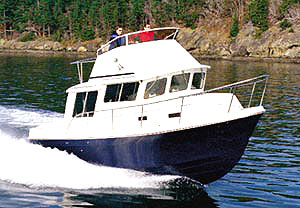Boat Test: Laser 3000
Perfect introduction to high-performance sailing
Laser told us their newest boat was aimed at the youth market so Peter Bentley took four-time youth world champion Sally Cuthbert and two-time Olympic representative Shirley Robertson along with him to test out their latest mint-green offering. Despite the weather it proved to be fun, fun, fun.
There are few things that will keep Robertson out on the water for long on a cold winter day, so her unexpected request for another sail in the Laser 3000 when the rest of us were ready to call it quits says something pretty serious about this adrenaline-inducing little boat. Make no mistake; in a breeze this is a real pocket rocket. Simply put, this is 80 percent of the performance of its bigger sisters with just a fraction of the drama.
Rigging is as easy as any spinnaker trapeze boat ever can be. Recognizing that this is the kind of boat that will sell to first-time owners and those moving up from una-rigged singlehanders, Laser has paid special attention to keeping things as obvious as possible. For those attempting to rig the boat the first time, there is also an exceptionally clear and well laid out instruction booklet with a diagram of every system.
Afloat, simplicity remains key. With the jib furled, the partially-battened mainsail hoists easily and all the halyard tails stow in a pocket on the side of the spinnaker sock. All that remains is dropping in the centerboard and you're off. Resist the temptation to drag the sheets in too hard and genuine upwind pace will be easy to find. The secret, of course, as with all serious trapeze boats, is to get the boat moving quickly and then use the apparent wind to give you height. The jib, with its two-to-one sheets, is especially easy to over-trim. Similarly, the helmsman must resist the temptation to luff more than a fraction in the gusts; much better to feed the mainsheet and keep the boat on its feet and moving quickly. To this end both sheets seem better kept out of their respective cleats (though both are nicely angled for easy cleating and release). Perhaps those Australian skiff sailors with their directly led mainsheets know something after all.
Balance proves excellent in every respect. The helm is light yet positive with increasing amounts of heel sending a distinct message to the helmsman without ever overwhelming him. Similarly, fore and aft trim is clearly a factor in getting the best from the boat and, as with any two person dinghy, it pays to keep close together. Far from slow upwind, the 3000 shows its quickest turn of heel in the other direction. With the single line hoisting system led forward, getting the big sail up is definitely crew's work. Largely friction free, the system works well with the pole extending and the kite popping up with just a couple of big pulls. From here it's clip on, sheet in and hold on: acceleration is in the sports car class.
As with virtually all bowsprit boats, a small degree of heel is required to keep the rudder neutral and controlling the angle precisely is the key to maximizing speed. Too much heel sees the rudder dragging to keep the boat straight, while too little leaves things feeling very neutral. With a tight turn to the bilge towards the aft end, the hull form is perhaps more sensitive than it need be in this respect. Lacking the width of its bigger sisters, the 3000 is more sensitive to gusts, heeling more quickly with increasing breeze. Though this in itself presents no problems, decisive helming is required to keep the boat moving at maximum speed. Leave the bear-away too late as a gust strikes and increasing heel can make it difficult to get down at all without unleashing the spinnaker.
The 3000 sensitive to fore and aft trim, too. With the kite up the bow rides high in flat water at least, and there is less need to get down to the back than you might expect. All these are minor details when set against the blistering ride and essentially easy control. This is sailing in a cloud of spray at its best and all in a small and easily managed boat. Down in the gusts, luff in the lulls, power, power, power. The 3000 is fast. Just how fast only really comes to light when Shirley and Sally ploughed into the back of the powerboat wake and, though Sally didn't quite make it to the forestay, the deceleration was quite enough to ensure she had a serious sized bruise the next day.
Gybing and indeed all maneuvering is easier than one might expect. Narrow by the standards of most modern "rack" boats the distance from one side to the other is just a single step. Although there is a conventional kicker to hinder the crew, the cockpit layout is so clean and tidy that moving around presents no problems. Getting the kite down is no harder than getting it up; athough, with the crew in off the wire, it's essential to set up to run deep while actually getting the thing away. A neat elastic keeps the halyard from dropping back into the cleat once it's released, and with a couple of big pulls the sail's back in the bag ready for the return trip.
Having only sampled the boat in light winds for the briefest of moments as we left the river, it's hard to predict how it will perform in less windy conditions. One can deduce that the hull form, derived from the Laser 2, served well across a range of wind conditions in its previous life and there is no reason to suggest it should do otherwise now. Downwind it will undoubtedly prove necessary to sail big angles to make good progress, though one suspects that the opposite will be true going the other way. Height, not speed, will almost certainly be the key to maximizing windward ability before the little boat starts to plane.
Although we managed to capsize on several occasions during the test, recovery was never anything but fast and trouble free. Showing little propensity to invert, even a relatively small crew on the centerboard maintained a stable position while the spinnaker was gathered away. This done, a short walk down the centerboard produced rapid results in the mast raising department, with the helmsman scooped in as the boat came up. Even with the mast upwind of the hull there is little drama and with the freshly arrived helmsman's weight more than enough to stop the boat from flicking over into the all too often seen, and exhausting, capsize-recover-capsize routine.
Windy or light, the deck layout is a tremendous improvement over what went before. Clean, simple and uncomplicated, the wide cockpit and narrow side decks provide plenty of space for both the helm and crew. In the back of the bus the helmsman has little more to worry about than the mainsheet, though both Shirley and Sally reckoned that a slick helmsman would be able to reach in and adjust the kicker on the move. Of all the controls on the boat, however, this was the only one really lacking purchase, and there were plenty of times when it would have been nice to "get a bit more on." All the other controls are very much in the crew's department and, though they are easy enough to adjust from the middle of the boat, there's no chance of getting anything done from out on the wire. "Set and forget," at least for the duration of each leg, seems to be the order of the day.
Construction follows the usual Laser "bullet-proof" philosophy with both the hull and equipment designed to absorb the rigors of life. The hull and deck are a simple single-skin glass/polyester laminate while the foils and rudder stock carry over from well-proven designs on the Laser 2. Though the rudder stock is adequate for the job, the downhaul rope does require the complication of a rope loop double purchase to make it really effective; simple if you know how, but not as simple as some of the click-and-lock designs found elsewhere.
Supported by both upper and lower shrouds, the Proctor mast is both easily adjustable and highly stable. Rigging is simple with a forestay attached above the hounds fixed temporarily to the bow eye until the jib is up. With that done the wire then comes aft, tying off to the base of the mast for sailing, eliminating the risk either of spinnaker tangles or getting the forestay wound in with the furling jib. Though it would of course be perfectly possible to use a trapeze wire in place of the temporary forestay, the simplicity offered by the system Laser have chosen is very much in keeping with the general concept of the boat.
The sails from Hyde are an interesting hybrid of technologies and materials. The Mylar mainsail looks suitably specified and with two full length top battens it should keep its shape for quite a while. These two long top battens give a stable and well-supported roach, delivering plenty of power from the top of the rig while the transition to shorter battens further down the sail makes the whole thing easier to handle both ashore and afloat. Ease of handling is also a key feature of the furling jib and the ability to roll it up is very welcome both ashore and, more particularly, afloat. And not just between races. Though it may not be quite so efficient, the ability to furl the jib makes things altogether easier for the novice spinnaker trimmer. Not only is it possible to see the whole sail, but there is one fewer set of sheets to worry about in the gybe. As might be expected from a team as experienced as Hyde and Laser, all the sails including the spinnaker are well developed and soundly put together.
The ability to reef will also be welcome to many. For those simply learning to deal with a spinnaker and trapeze for the first time, the attraction is obvious; while for the more adventurous, the smaller main makes single-handed sailing a very real possibility. With its balance of performance and ease of handling the Laser 3000 seems well suited to a number of different markets. From the point of view of the youth market it is small enough for those graduating from Optimists to cope with while still offering a level of performance that will serve well as a training ground for those aspiring to move on to bigger high performance boats. Likewise, the Laser 3000 also has a role in getting those people afloat in fast boats who might not have previously thought it within their skills. Unintimidating to sail, the 3000 is well within the capabilities of almost any crew. The light loads, easy capsize recovery and essentially vice free handling all conspire to make it a confidence inducing boat. Simplicity, speed and forgiving manners make it a perfect introduction to genuine high-performance sailing.
Boat Specifications
| LOA | 4.4 m |
| Beam | 1.46 m |
| Hull Weight | 79 kg |
| All-up Weight | 97 kg |
| Mainsail area | 8.6 sq. m |
| Jib | 2.94 sq. m |
| Genniker | 12.8 sq. m |
| Price inc Vat | 4,695 |
For more information, contact:
The Laser Centre
6 Riverside, Banbury
Oxon OX16 8TL
Phone: +44 12 95 268191












